When it comes steak, there are just so many ways to cook it. And with all those options, it can, it can be tough to choose. The reverse searing method is definitely the one you want to try for restaurant-quality steaks right at home.
Cooking a big, beautiful and likely really expensive steak to perfection can be tricky. You can sweat it out wondering whether the interior will be that highly sought-after medium-rare or if you’ve just ruined $50 piece of beef. The (better) alternative is that will make it stress-free is simply by slowing things down, and initially cook it through at a low temperature, then sear it to perfection.
What is Reverse Searing, Anyway?
The method for reverse searing a steak is quite simple. You will first cook the steak in a low-temperature oven for a nice, slow and even cook, then quickly sear it over high heat for that beautiful flavorful crusty exterior. Steaks that are reverse seared are perfectly and evenly cooked from edge to edge, without a big grey layer of overcooked beef.
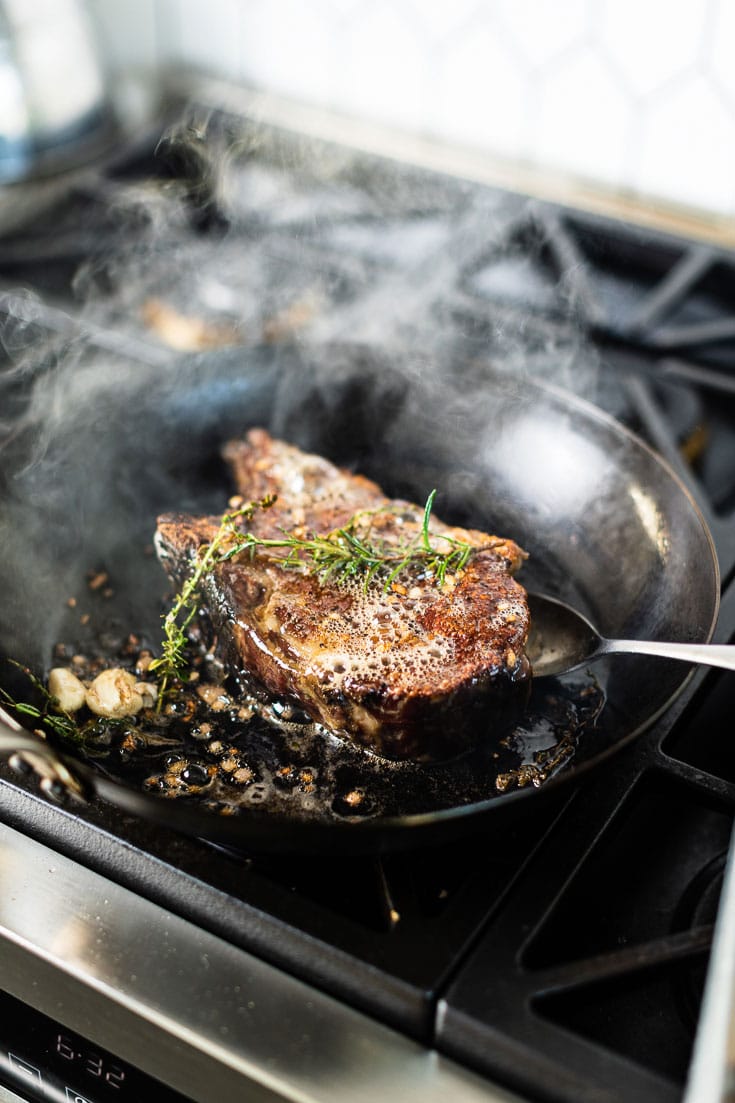
I first learned to cook steak by watching chefs in a French restaurant. The technique they used was the complete opposite (or reverse) of what we’re talking about in this recipe. They would sear a beautiful steak in a carbon steel skillet over extremely high heat, flip it and then right into the oven it would go until it was to temp. Then they would finish it with butter and herbs. This method works! And it’s actually pretty fast (and what you need in a fast-paced restaurant). However, reversing that process is even more magical and relies less on perfect timing.
Your favorite steakhouse has been reverse searing for years. Reverse searing was developed in the early 2000s, as a sort of sous vide hack, to get the even cooking temps of a sous vide device without the extra expensive equipment.
When you don’t have an immersion circulator to utilize the sous vide method, just reverse sear your beautiful steak. Even with the ability to sous vide, there are definitely some great advantages to the reverse sear.
Advantages of Reverse Searing
- The steak comes out of the oven dryer than with the sous vide method, so you will get a better crusty sear in a shorter amount of time, which adds amazing flavor.
- It’s way hard to mess up — because of the low temp oven. It won’t overcook as quickly as it will in a hot oven, so expert timing isn’t needed.
- More flavor development during the slow cook and the slow cook also means the fat melts and becomes more tender.
How to Reverse Sear a Steak
Whether it’s in the oven, the grill or in the smoker, step-by-step the method is the same.
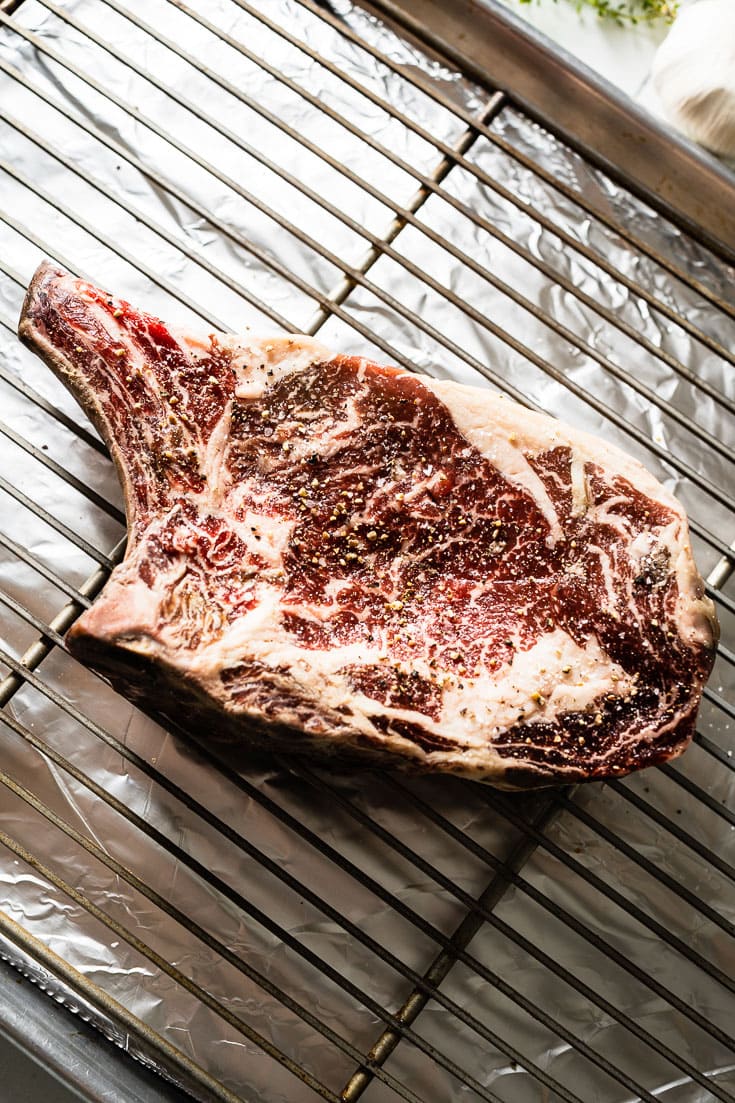
- Heavily season and temper the steak and place on a wire cooling rack on top of a foil-lined baking sheet.
- Preheat oven to 275° F (135° C), or lower if your oven is capable.
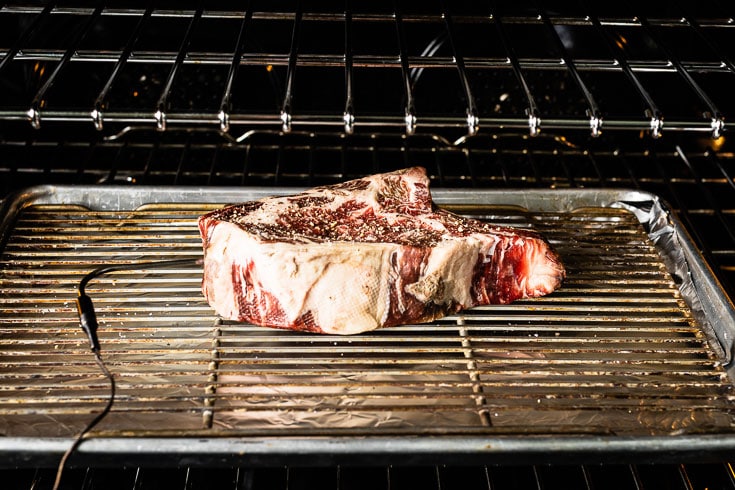
- Place the steak in the oven and cook until the internal temperature reaches the “pull temp” 120° F for med-rare (10 degrees below desired finished temp). See the time and temp chart for your preferred doneness. Use an instant-read probe thermometer to verify.
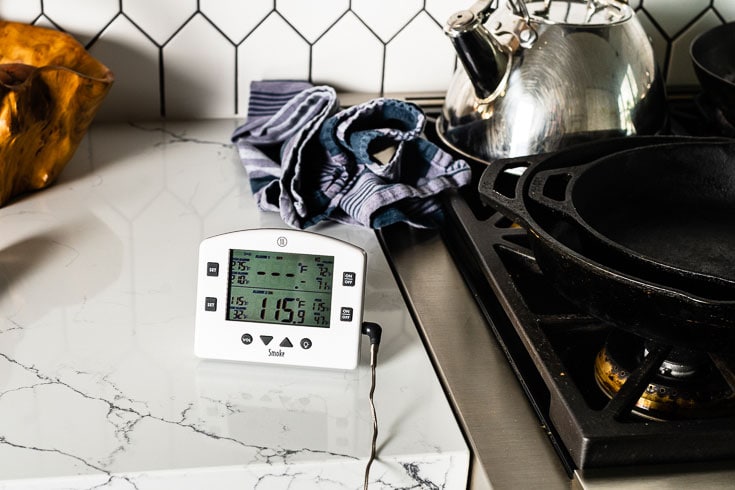
Tip: Use a remote thermometer to monitor the internal temperature of the steak while it cooks in the oven or grill.
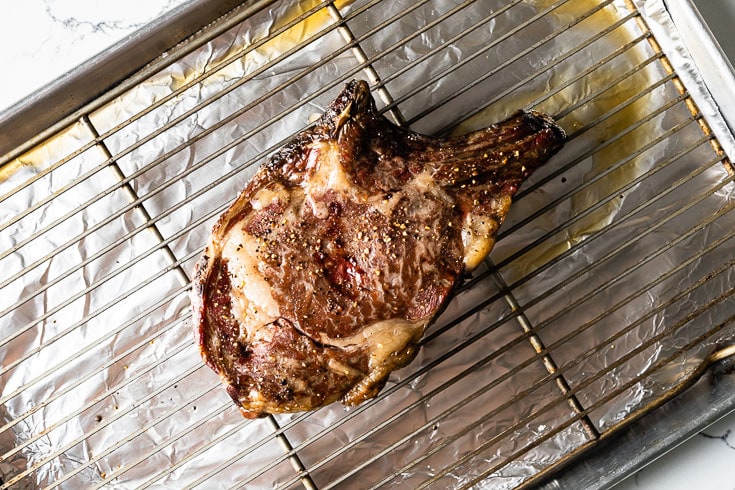
- Remove from the oven and rest the steak for 10 minutes to let it cool slightly before searing to prevent it from overcooking around the edges.
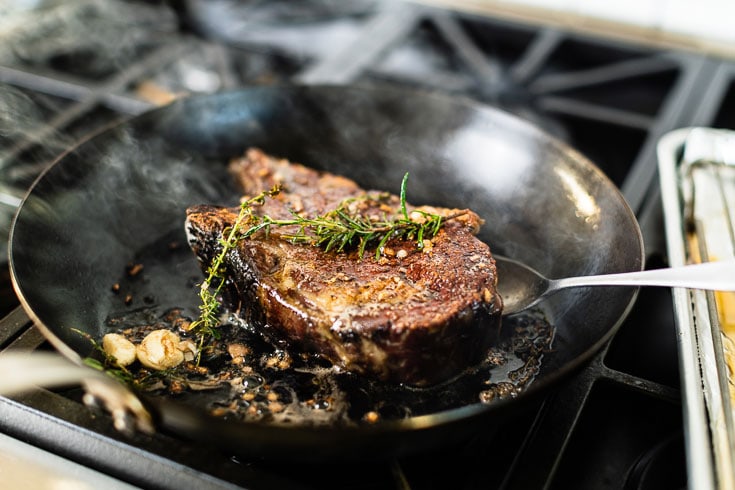
- Heat a heavy cast iron or carbon steel skillet over high heat until it begins to smoke. Then add about 1 tablespoon canola, other high smoke point oil or beef tallow.
- Sear the steak for 2 minutes per side. (Optional: Add butter and herbs to the skillet and baste while the steak sears.)
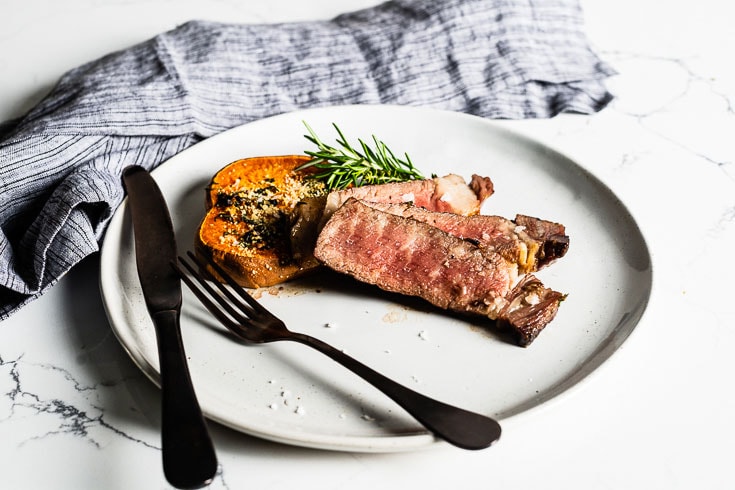
- Slice against the grain and enjoy with a sprinkle of coarse salt.
Ingredients and Equipment
- A high-quality steak (at least 1 1/2″ thick)
- Kosher Salt & Ground Pepper
- Baking sheet pan
- Wire cooling rack
- An oven, BBQ grill or smoker
- Oven probe thermometer
- Thermapen instant-read probe thermometer
- High smoke-point neutral oil (such as canola or peanut oil). You can also use beef tallow for searing.
- Skillet for searing such as a carbon steel or a cast iron skillet
Times and Temps
| Steak Doneness (1 1/2 to 2″ Steak) | Pull Temperature (remove from oven) | Final Temperature (after sear) |
| Rare | 115°F | 125° F / 52°C |
| Medium-Rare | 120°F | 130° F / 54° C |
| Medium | 130° F | 140° F / 60° C |
| Medium-Well | 140° F | 150° F / 66°C |
- Don’t rely on cook times. Rely on internal temperature with an instant-read probe thermometer.
- The pull temperature is 10 degrees Fahrenheit below the final target temperature.
- The chart shows target temps and not a range, so feel free to vary by +/- 5 degrees to make it to your preference.
- Start checking steak doneness in the oven after 30 minutes, but it usually takes 40 minutes to an hour or more depending on your oven or grill and other variables of cook time.
- Since you are using a low temp oven, there isn’t nearly as much carryover cooking as there would be with a hot oven.
Pro Tips for Success
- Use thick-cut steaks that are at least 1 1/2″ thick.
- Buy one larger steak rather than two smaller ones. Slice and share.
- Buy the best steak you can. Less is more.
- Season the steak well ahead of time (24 hours before cooking). This will allow the salt to fully penetrate the meat and act as a dry brine, bringing out the flavor and making it more tender.
A Bone-In Ribeye Is Perfect for Reverse Searing
This (IMO) is the ultimate steak, with its combination of flavor and marbling, with differing textures. Being the ultimate steak, it needs to be cooked the ultimate way for perfect results that will seriously just melt in your mouth as you melt into your chair with disbelief that something could taste so good.
For the ultimate in high-quality dry-aged and American Wagyu Steaks that can be ordered online; check out Snake River Farms.
Reverse searing isn’t just for steaks. It is a wonderful way to cook a roast to perfection as well. The concept is exactly the same, it’s just going to be cooking for longer. This is how I cooked our holiday standing prime rib roast and it was melt-in-your-mouth perfection.
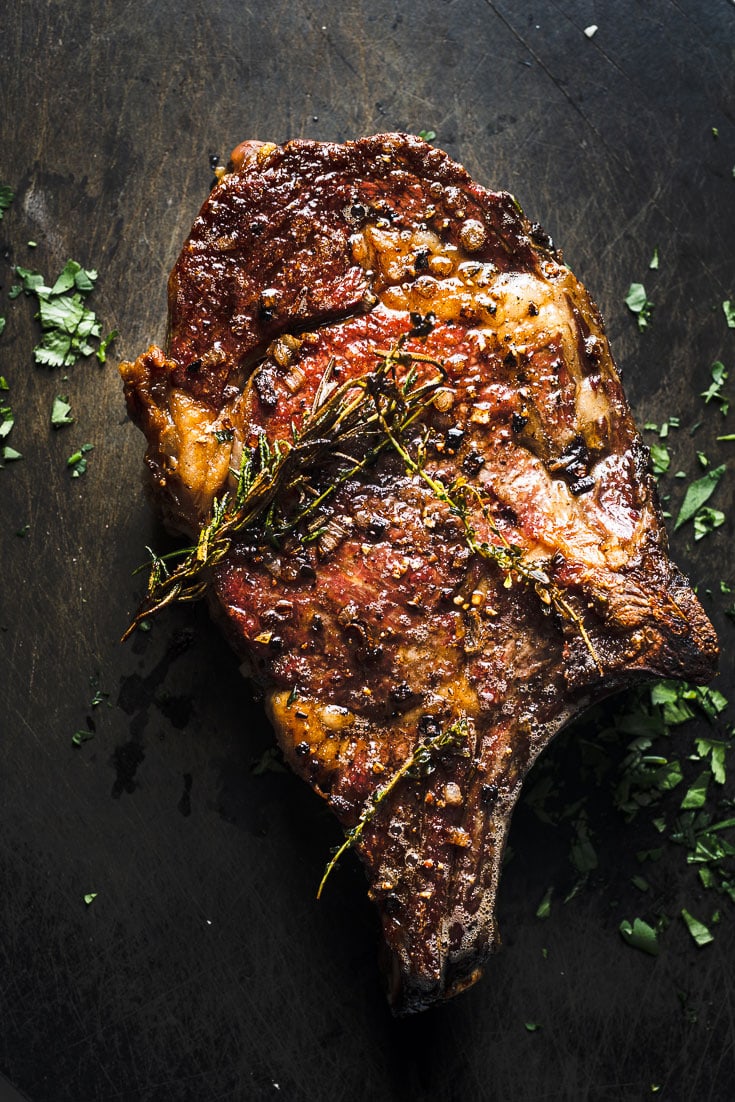
To Reverse Sear in a Grill or Smoker
The oven isn’t the only way to reverse sear a steak. A grill with the ability to cook with indirect heat and the lid closed or a smoker are fantastic for the reverse sear method. The advantage of using a grill or a smoker is that additional flavors from the smoke of the charcoal and/or wood chips can be infused into the meat while it cooks. Check out this reverse seared picanha steak recipe made in the smoker.
The only downside is that controlling the temperature of some grills can be more difficult than the oven in your house.
Cooking a steak reverse sear will take between 40 and 60 minutes plus 4 minutes of total sear time.
Set your oven as low as it will go, which is usually between 250° and 275° F. A lower oven temp will cook the steak more evenly and make the steak even more tender, but will increase the cook time, so just start a little earlier.
Sauce Inspiration
While a sauce is totally optional, but it brings it to another level.
More Delicious Steak Recipes
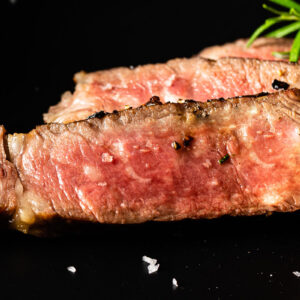
Reverse Seared Steak
Ingredients
- 1 steak (1 1/2" to 2″ thick cuts such as a ribeye, New York or filet mignon)
- 2 tsp Diamond kosher salt (half on each side)
- 2 tsp ground black pepper (half on each side)
- 1 tbsp neutral oil (such as peanut, canola oil or even beef tallow)/
Optional for butter basting
- 2 tbsp unsalted butter
- 3 sprigs fresh herbs such as thyme and rosemary sprigs
- 1 minced shallot
- 2 smashed whole garlic cloves
Instructions
- Season the steak heavily with kosher salt at least 1 hour prior to cooking. Place the steak on a cooling rack on top of a parchment paper or foil-lined sheet pan.
- Preheat your oven to 250° F to 275° F (however low your oven will go)
- Place the steak in the oven and cook until the internal temperature of the steak reaches the desired "pull temperature," 120°F for medium-rare (10 degrees below your target finished internal temperature). *See chart for other temperature options.
- Remove from oven and rest the steak uncovered for 5 to 10 minutes to let cool slightly before searing.
- Heat up a heavy-bottom skillet (preferably cast iron or carbon steel) over high heat until it just starts to smoke, then add about 1 tablespoon of neutral oil and let heat through for about 30 seconds.
- Carefully place the steak in the skillet to sear for 2 minutes per side. Add the butter and herbs (if using) after about 1 minute and baste the melted butter onto the steak with a spoon as it sears.
- Slice against the grain and serve immediately with a sprinkle of coarse finishing salt.
Notes
- Buy one larger thick-cut steak rather than two smaller ones.
- Season your thick-cut steak right when you bring it home (up to a day before cooking). This will allow the salt to fully penetrate the meat and act as a dry brine.
- Use a probe thermometer in the oven. It’s easy and ensures a proper temp without guesswork.
- Don’t sear for more than 2 minutes per side, or the steak can overcook.
- There is no need to rest after the sear.

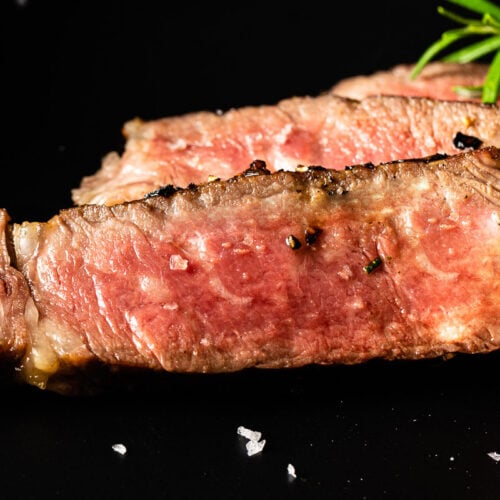
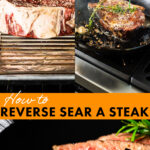
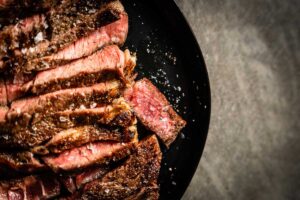
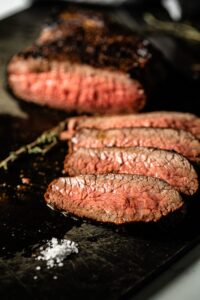
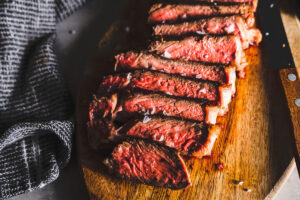
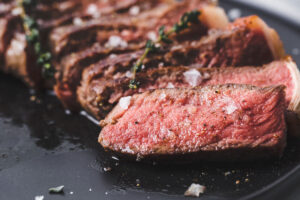
People are sleeping on safflower oil. That is the one to use. It has a super high smoke temp (maybe the highest?) And is about as neutral as it gets.
Sounds great, Mork. You can also use beef tallow, which you can easily make yourself from brisket trimmings or other beef fat.